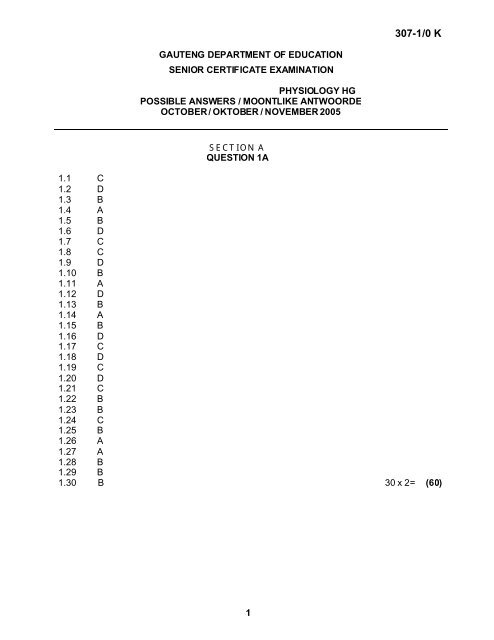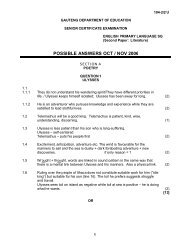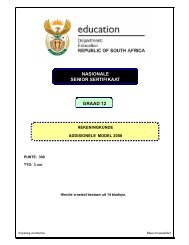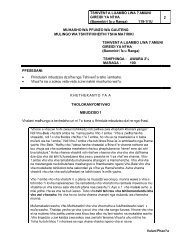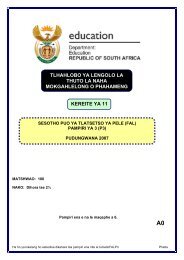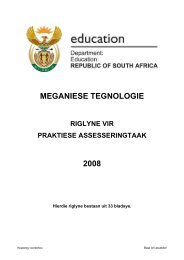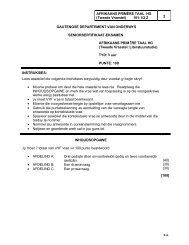View Paper
View Paper
View Paper
You also want an ePaper? Increase the reach of your titles
YUMPU automatically turns print PDFs into web optimized ePapers that Google loves.
307-1/0 K<br />
GAUTENG DEPARTMENT OF EDUCATION<br />
SENIOR CERTIFICATE EXAMINATION<br />
PHYSIOLOGY HG<br />
POSSIBLE ANSWERS / MOONTLIKE ANTWOORDE<br />
OCTOBER/ OKTOBER / NOVEMBER 2005<br />
SECTION A<br />
QUESTION 1A<br />
1.1 C<br />
1.2 D<br />
1.3 B<br />
1.4 A<br />
1.5 B<br />
1.6 D<br />
1.7 C<br />
1.8 C<br />
1.9 D<br />
1.10 B<br />
1.11 A<br />
1.12 D<br />
1.13 B<br />
1.14 A<br />
1.15 B<br />
1.16 D<br />
1.17 C<br />
1.18 D<br />
1.19 C<br />
1.20 D<br />
1.21 C<br />
1.22 B<br />
1.23 B<br />
1.24 C<br />
1.25 B<br />
1.26 A<br />
1.27 A<br />
1.28 B<br />
1.29 B<br />
1.30 B 30 x 2=<br />
(60)<br />
1
307-1/0 K<br />
QUESTION 1B<br />
1.31 Dura mater<br />
1.32 Aquaduct of Sylvius<br />
1.33 Folia/lamellae<br />
1.34 Foramen magnum<br />
1.35 Autonomic nervous system<br />
1.36 Noradrenalin<br />
1.37 Stimulus<br />
1.38 Dendrite/afferent branch<br />
1.39 Nodes of Ranvier<br />
1.40 Micturition<br />
1.41 Pancreas<br />
1.42 Hypophysis/Pituitary gland<br />
1.43 Neurilemma<br />
1.44 Neuron<br />
(14)<br />
QUESTION 1C<br />
1.45 Bladder - Stores urine<br />
1.46 Ureter - Conveys urine from the kidneys to the bladder<br />
1.47 Ejaculatory duct - Strong muscular contractions helps expel semen<br />
during ejaculation<br />
1.48 Cowper’s gland - Secretes alkaline mucus to neutralise acids in urethra<br />
and vagina<br />
1.49 Urethra - Transports urine and semen out of body<br />
1.50 Epididymus - Maturation (10 – 14 days) of spermatozoa OR<br />
Storage of spermatozoa until fertile<br />
1.51 Testis - Produce spermatozoa through spermatogenesis<br />
1.52 Penis - Transfer semen to upper part of vagina to ensure<br />
that spermatozoa are closer to ovum<br />
Ensures internal fertilization<br />
(16)<br />
TOTAL FOR SECTION A: [90]<br />
SECTION B<br />
QUESTION 2<br />
2.1 2.1.1 A. Adrenaline B. Glucagon (2)<br />
2.1.2 a) Adrenalv medullav (2)<br />
b) Fight or Flight hormone / sympathetic activator (1)<br />
c) – Vasodilation in skeletal and heart muscle/<br />
vasoconstriction of gastro-intestinal tract and skin/<br />
increase blood pressure<br />
– Increase in oxygen content of blood/breathing rate and depth<br />
increases so that more oxygen is inhaled<br />
2
– Heart rate and stroke volume increases, more blood with<br />
more oxygen to muscles to produce more energy<br />
– Pupils of eye dilate, due to contraction of radial muscles –<br />
better vision<br />
– More ACTH released – cope more effectively with stress<br />
– Increased sweating to cool body<br />
– Gastro-intestinal activity reduced as energy is needed for<br />
skeletal muscles<br />
307-1/0 K<br />
– Sphincter of bladder relaxes and the sphincter of the large<br />
intestines contract (Any 7 of 8) (7)<br />
2.1.3 Sympathetic nervous system (1)<br />
2.2 Sensory nerve 1 diagram<br />
1 heading<br />
5 labels (7)<br />
3
307-1/0 K<br />
2.3 2.3.1 1. Dura mater<br />
2. Arachnoid mater<br />
3. Pia mater<br />
4. Posterior/Dorsal fissure<br />
5. Ganglion/posterior root ganglion<br />
6. Central canal<br />
7. Ventral/anterior fissure (7)<br />
2.3.2 – The afferent impulses from the limbs and other parts of the body<br />
are conducted via ascending tracts to the brain.<br />
– The efferent impulses are conducted via descending tracts in the<br />
spinal cord to the effectors in the body and limbs.<br />
– The sympathetic and certain parasympathetic reflex arcs have their<br />
cell bodies in the spinal cord.<br />
– Seat of primitive reflex actions, called spinal reflexes<br />
– Inhibitory neurons from the brain innervate certain motor neurons<br />
thereby stopping reflex actions from taking place. (5)<br />
2.3.3 a) If no. 8 is damaged, the person will have no sensationv as the<br />
sensory neuronsv are damaged. (2)<br />
b) If no. 9 is damaged, the person will have no reactions/movementsv<br />
as the motor nervesv are damaged. (2)<br />
2.3.4 a) Vestibulum and the cochlea in the ear. (2)<br />
b) This nerve has sensory branches as well as motor branches<br />
(consists of sensory neurons as well as motor neurons). (2)<br />
[40]<br />
QUESTION 3<br />
3.1 3.1.1 37,6º C (2)<br />
3.1.2 50 or 51 units (2)<br />
3.1.3 a) Internal body temperature droppedv between the 10 th and 25 th<br />
minutes until it reached 37º Cv. (2)<br />
b) Skin temperature increasedv until it reaches 37,6º Cv. (2)<br />
c) Sweating rate decreasedv until it reaches 10 units. v (2)<br />
4
307-1/0 K<br />
3.1.4 When the internal blood temperature decreasesv the hypothalamusv is<br />
stimulated. Impulses are sent to the vasomotor centre in the medulla<br />
oblongata. Impulses are sent to the smooth muscles in the walls of the<br />
arterioles in the skinv to contractv vasoconstriction occurs.<br />
Less warm blood flows to skinv less heat lossv through radiationv,<br />
convectionv and conductionv.<br />
Lower sweat productionv – less heat loss through evaporationv<br />
Erector muscle contractsv trapping a layer of air as insulation. v More<br />
thyroxin secretedv – more heat produced caused by higher metabolic<br />
ratev. More adrenaline is secretedv stimulates conversion of glycogen to<br />
glucose. v Muscle tone increasesv – shiveringv – more heat energy<br />
generatedv. Body temperature will increase. v<br />
(20)<br />
3.2 The skin:<br />
•<br />
•<br />
•<br />
•<br />
•<br />
•<br />
Produces melanin which protects the body against the harmful UV rays of<br />
the sun.<br />
Produces Vitamin D from steroids in the skin.<br />
Acts as a secretory organ – milk, sebum, cerumen.<br />
Waterproof layer, prevents excessive loss of water.<br />
Cornified layer protects/prevents entry of germs and bacteria.<br />
Cornified layer protects the body against mechanical injuries. (Any 5 of 6) (5)<br />
3.3 a) Endothermic<br />
4.1<br />
Body heat is obtained from inside the body and causes the body<br />
temperature to stay constant. (2)<br />
b) Homeostasis<br />
Maintenance of a constant internal environmentv for normal cell<br />
functioningv by self-regulating mechanisms. v (3)<br />
[40]<br />
QUESTION 4<br />
Graph<br />
Strongest<br />
Taste<br />
Region on<br />
tongue<br />
Substance<br />
causing the taste<br />
Papilla sensing the<br />
taste<br />
A Salty Sides/tip Sodium Fungiform<br />
B Sour Sides Hydrogen ions Fungiform<br />
C Sweet Tip/front Sugars Fungiform<br />
D Bitter Back Quinine Circumvallate (16)<br />
4.2 4.2.1 Chemoreceptors<br />
4.2.2 Food particles dissolve (1) in saliva. v<br />
Substances in solution/dissolved substances. v<br />
Stimulate the receptor cells/sensory hair cellsv in the taste budsv which<br />
convert the stimulus into an impulse/triggers series of impulsesv<br />
conducted via sensory neuronsv to temporal lobe of cerebrumv where<br />
sensation of taste rises/ interpreted. v<br />
any<br />
(1)<br />
(8)<br />
5
307-1/0 K<br />
4.3 Filliforme papillae (1) is sensitive to touch (1) e.g. hair. (2)<br />
4.4 4.4.1 a) Between measurements 1 and 2<br />
b) Between measurements 5 and 6 / 6 and 7.<br />
(1)<br />
(1)<br />
4.4.2 a) At measurement 4 (1)<br />
b) At measurement 8 (1)<br />
4.4.3 The bright light of the torch was the same distance from the eye.<br />
4.4.4 The closer the bright light source is to the eye<br />
– the smaller the diameter of the pupil.<br />
– Less is the light allowed into the eye.<br />
– The more protected is the sensitive retina on the inside. (3)<br />
4.4.5 Acromatosis/total colour blindness/v no sensitivity to colour, only shades of<br />
grey, black and whitev.<br />
Red-green colour blindnessv – red or green cones are missingv<br />
cannot distinguish between red and greenv see either red or greenv. (5)<br />
[40]<br />
QUESTION 5<br />
5.1<br />
COLUMN A<br />
COLUMN B<br />
NAME OF RECEPTOR<br />
PART OF BRAIN<br />
1. Cones G<br />
2. Rods G<br />
3. Crista H<br />
4. Macula H<br />
5. Organ of Corti C<br />
6. Corpuscles of Ruffini /<br />
E/F<br />
Free nerve endings<br />
(12)<br />
5.2 5.2.1 Cerumen/wax glandsv – secretes cerumen/waxv<br />
– prevents skin from drying outv<br />
– pungent smell repels insectsv (4)<br />
5.2.2 Ball of cerumen accumulates in front of tympanumv and inhibits the<br />
transfer of sound waves/prevents it from vibrating. (2)<br />
6
Answer Question 6 or Question 7.<br />
QUESTION 6<br />
307-1/0 K<br />
5.3 Specialized cells in the afferent arteriole/jutaglomerular cellsv<br />
respond to the decrease in sodium concentrationv<br />
or drop in blood pressure/blood flowv.<br />
or sympathetic stimulationv<br />
by secreting the enzyme reninv which causes the production of angiotensinv<br />
which stimulates the secretion of aldosteronev by the adrenal cortexv<br />
aldosterone travels through the bloodv to the distal convoluted tabulev<br />
where it stimulates the reabsorbtion of sodium ionsv<br />
chlorine ions follow passivelyv into the peritubular capillariesv<br />
water follows passively/by osmosisv<br />
increase in blood pressurev. (12)<br />
5.4 5.4.1 Secondary oocytev and the first polar bodyv. (2)<br />
5.4.2 Spermatozoa reaches the ovum in the fallopian tubev<br />
Acrosomev will secrete hydrolytic enzymesv that will dissolve the<br />
Zona pellucidav / follicle cells / corona radiate.<br />
Only the head of the spermatozoa enters the ovumv<br />
The tail is discarded ofv.<br />
The fertilization membranev prevents other sperms from entering.<br />
The second meiotic divisionv takes place to form the ovum and 3 polar<br />
bodiesv which disintegrate.<br />
Fusion of the nuclei of the sperm and ovum takes place to form a zygote<br />
with 46 chromosomes (2n)v. (Any 8 of 11) (8)<br />
SECTION C<br />
TOTAL FOR SECTION B: [160]<br />
6.1 1. Posterior Hypophysis/Neurohypophysis<br />
2. Anterior Hypophysis/Adeno Hypophysis (2)<br />
6.2 3. Oxtytocin – release and the flow of milk from the mammary glands<br />
4. Prolactin – stimulates milk production (4)<br />
6.3 Oxytocin ( √) is not only responsible for the flow of milk but also for the<br />
contraction of the uterus. ( √). While breastfeeding the secretion of oxytocin<br />
is stimulated, ( √) resulting in the contraction of the uterus back to its normal<br />
size. ( √)<br />
(4)<br />
6.4 9. Fallopian tube<br />
10. Infundibulum<br />
11. Fimbriae<br />
13. Vagina (4)<br />
7
307-1/0 K<br />
6.5 a) Endometrium<br />
Myometrium<br />
Perimetrium<br />
b) Fundus<br />
Corpus<br />
Cervix (6)<br />
6.6 ICSH ( √) – Stimulates the cells of Leydig (Intestitial cells) ( √) to secrete<br />
testosterone. ( √) (3)<br />
6.7 Vasectomy, Male condom, Withdrawal method, Male pill. (Any 3) (3)<br />
6.8 6.8.1 If fertilization takes place:<br />
LH concentration is high (1) – to maintain the corpus luteum (1)<br />
Progesterone concentration is high (1) – secreted by the corpus luteum (1)<br />
– to maintain the endometrium (1)<br />
– stop uterus from contraction/abortion/miscarriage (1)<br />
Oestogen concentration is high (1) – prepares breasts for milk<br />
production (1) prepares endometrium for implantation (1) inhibits<br />
FSH secretion/Low FSH (1) to prevent a Graafian Follicle from<br />
developing (1). (Any 10) (10)<br />
6.8.2 Just after ovulation, the remains of the Graafian Follicle from the Corpus<br />
Luteum (1) which secretes progesterone (1) and oestrogen (1).<br />
These two hormones maintain the uterus (1) during pregnancy.<br />
After 3 months, the placenta will be fully developed (1) and will then<br />
secrete these two hormones (1). Then the ovaries are not needed to fulfil<br />
this function anymore and can be removed.(1) (Any 6) (6)<br />
6.9 The testis<br />
Two oval glands (1) carried in the scrotum (1).<br />
Fibrous connective tissue divides testis in lobules (1)<br />
In each lobule are highly convoluted tubules ( √)<br />
– the seminiferous<br />
tubules (1) – which unite to form straight tubules (1) – which unite to form<br />
straight tubules (1) – which is their turn unite to form the rete testis (1) –<br />
that joins to enter the epididymis (1). (Any 5 of 8) (8)<br />
[50]<br />
8
307-1/0 K<br />
QUESTION 7<br />
7.1 The kidney regulates the water content of the blood (osmoregulation)<br />
Regulates the pH of the blood/acid - base balance.<br />
Regulates the sodium content of the blood/regulates electrolytes.<br />
Excretes metabolic waste/nitrogenous waste. (4)<br />
7.2 7.2.1 70 mmHg – 14 mmHg = 56 mmHg √√<br />
(2)<br />
7.2.2 125 ml/min √ x 60 √ = 7 500 ml/hour (3)<br />
7.2.3 a) 1 ml/min x 60 √ x 24 √ = 144 ml/day √ = 1,44 l/day √<br />
(4)<br />
b) On a hot summers day a person loses more water through<br />
sweat √, thus less urine will be produced. √<br />
(2)<br />
c) When the body becomes dehydrated √ /<br />
when body loses too much water through sweat<br />
the osmotic pressure in the blood rises √<br />
osmoreceptors √ in the hypothalamus √ are stimulated<br />
causes an impulse to be sent √ to the neurohypophysis √<br />
which is stimulated to secrete ADH √.<br />
ADH travels with the blood √ to the kidney.<br />
The collecting ducts √ and distal convoluted tubules√<br />
become more permeable √ to water.<br />
More water will be reabsorbed √ by osmosis√<br />
into the peritubular capillaries√<br />
increasing the blood volume/ decreasing the osmotic pressure√<br />
(Any 11 of 15) (11)<br />
d) Proteins, white-blood cells, erythrocytes, platelets. (Any 3 of 4) (3)<br />
e) The basements membrane of the capillaries is thin√<br />
The single √ endothelial layer has many pores √<br />
The podocytes in the Bowman’s capsule has filter slits √ (Any 3 of 4) (3)<br />
7.2.4 125 ml/min – 25 ml/min = 100 ml of water per minute √ passively √<br />
reabsorbed in the proximal convoluted tubule. √<br />
(3)<br />
7.2.5 A. No food<br />
Low Glucose level in blood√<br />
Low cellular respiration √ – not enough energy/ATP√<br />
Feels tired/weak √. Also influences osmotic pressure √<br />
(Any 3)<br />
Low ion concentration√<br />
Certain ions, namely sodium, potassium. Chloride, bicarbonate<br />
and phosphate must be present for proper cell functioning<br />
(At lease 2 examples) (2)<br />
9
Nitrogen waste√<br />
Due to the absence of glucose, the body uses proteins (of muscles) √ and<br />
the metabolism thereof will increase waste products like urea, creatinine,<br />
which will become toxic √<br />
(Any 2)<br />
B. No water<br />
Water is needed for metabolic reactions √ in cells, for transport medium, √<br />
affects the osmotic potential of fluids.<br />
Hormone concentration will be influenced√<br />
Water is needed to control temperature for effectiveness of enzymes and<br />
proteinsv. (Any 2)<br />
C. When he suffocates himself<br />
Low Oxygen concentration √ – low cellular respiration rate –<br />
energy released slower √<br />
(2)<br />
High Carbon dioxide √ concentration<br />
reacts with water to form carbonic acid √ which lowers the pH of the tissue<br />
fluid √<br />
(Any 2)<br />
307-1/0 K<br />
pH √ level drops below 7,0 due to CO 2 denature enzymes√<br />
metabolic processes cease. (2) (15)<br />
TOTAL FOR SECTION C: [50]<br />
TOTAL: 300<br />
10


